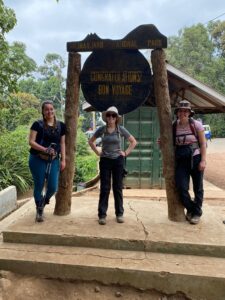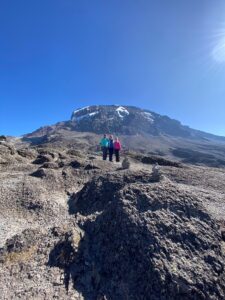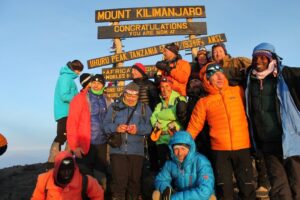
Small Groups.

Secured
Payments

Local Guides.

Easy Payments
About Kilimanjaro Mountain.
Conquer the majestic Kilimanjaro! Embark on a thrilling expedition to Africa’s highest peak, where breathtaking views and exhilarating challenges await.
Our experienced guides will lead you through the awe-inspiring landscapes, ensuring your safety and creating unforgettable memories. Prepare for the adventure of a lifetime on Kilimanjaro!
Start With us?
Kilimanjaro Mountain:Kilimanjaro trekking Equipment Check list
Here is a suggested list of clothing and accessories for climbing Mt.
Kilimanjaro:
- insulated, waterproof hiking boots with rigid uppers and thick sole
- (Boots must be WELL BROKEN IN. WE ALSO ADVISE THAT YOU WEAR YOUR CLIMBING BOOTS ON THE INTERNATIONAL FLIGHT OVER, IN-CASE YOUR LUGGAGE IS LOST BY THE AIRLINE. YOUR CLIMBING BOOTS ARE THE MOST IMPORTANT EQUIPMENT.
- 3 pair of warm socks
- 3 pair of lightweight socks (to wear under warm socks)
- 1 or 2 pair of lightweight walking or running shoes for walking
around camp (with appropriate socks) - 1 warm hat (or balaclava) with brim to keep the sun off face and
neck and a sun hat (you will need both types) - 1 pair of insulated hiking or ski gloves
- 1 down-filled, hooded parka or Gore-Tex anorak
- 2 sets of thermal underwear (preferably a lightweight pair to
wear next to the skin and a heavier second pair for extra warmth) - 1 pair of warm, windproof slacks
- 1 pair of lightweight slacks
- 1 pair of shorts
- 2 woolen or flannel shirts with long sleeves
- 1 or 2 warm sweaters (fleece-type)
- 2 lighter-weight shirts (or tee shirts)
- 3 or 4 sets of underwear
- Lightweight rain gear with hood (Rain can occur at any time on
the lower slopes.) - lightweight personal water container
- a water purification kit and/or iodine pills
- a lightweight daypack for carrying your own water, camera, film, etc.;
(A pack that has a hydration system with an insulated water
bladder is suggested. - A medium-size, sturdy duffel bag to contain all your gear and
clothing (Porters will carry this for you, but they will NOT carry
framed backpacks.) - Well-insulated sleeping bag suitable for temperatures of
20-degrees Fahrenheit (The sleeping bag should fit in your duffel
) - camping pillow (if desired)
- emergency foil blanket (optional)
- flashlight (with extra batteries); a head lamp will be
especially useful for the last part of the climb, which is done at
night - 2 walking sticks
- One pair of mud gaiters
- dark sunglasses with high UV ray protection or snow goggles
- (Polarizing glasses are not sufficient to prevent snow blindness.)
- sunscreen with high SPF
- lip balm containing a sun block
- small hand towel, soap, and 2 rolls of toilet paper
- tissue and “wash and dry” wipes
- UV filter for your camera (which is necessary for high-altitude
photography) - -high-energy snacks (such as muesli bars, chocolate, or instant
hot drinks) - a small reference book on plants (if you are interested in botany)
IN ADDITION, it is suggested that you assemble a basic medical
kit. Your doctor can advise you on specific items to include. The
following items may be useful:
- a good supply of aspirin (for altitude headaches)
- altitude medication — as prescribed by your doctor
- an antibiotic to use if needed (such as Septra DS) as prescribed
by your doctor - anti-biotic cream (for cuts and scrapes)
- band-aids and bandages
- moleskin
- scissors, tweezers, and a thermometer
- cold/flu tablets and throat lozenges
- medicine for stomach ailments and dehydration salts
Clothing of various weights is suggested, because you will want to
dress in layers (removing layers as you heat up from walking, adding
layers as you cool down from resting). During the first two days,
climbers may find it comfortable to wear shorts and t-shirts.
However, temperatures will change at higher altitudes. By the third
day of your climb, it can be very windy and the temperature can fall
to freezing at night.
A limited selection of equipment is available for rental at the
base of the mountain. It is, however, suggested that climbers bring
all of their own equipment.
MAASAILAND EXPLORER
Phone: +255655707352
Webmail; www.maasailandexplorers.com
Email: info@maasailandexplorers.com
Opening Hours:Mon – Fri, 9am – 6.30pm
Address: 275, Sombetini Road,
P.o.box 275, Arusha, Tanzania
Arusha, Tanzania.
Our Happy Clients!
Our Tanzania trip was fabulous. Spotting the Tree-climbing lions and Black Rhino was unforgettable. Thanks for fulfilling our dreams. We’ll be back soon!

Clara Smith
Thank you, Maasai Land Wonders Team, for your exceptional care during my 3 Months Volunteering program. A thousand thanks for an unforgettable experience.

Shelly Barns
Thank you, Edwin and your team, for an amazing 7-day trip. Your personal care and dedication made it unforgettable. 1000 thanks!

Jacob Luke
Contact us, We're at your Service.








Trusted by:

